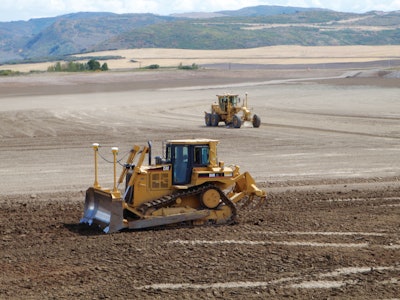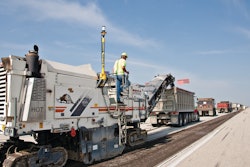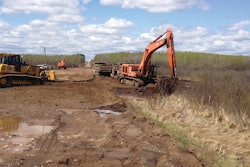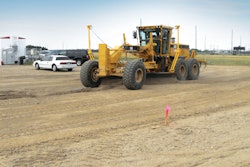
If Greg Haight, president of H&H Enterprises, Steamboat Springs, CO, is correct, in 10 years you won't hear any earthmoving contractor say, "I've never needed technology before, why do I need it now?" or "I'm not sure it's worth the investment." Why? Because he believes those contractors won't be around.
"In 10 years, if you don't have 3D GPS machine control technology, you're not going be in business," Haight states. "I don't care how big you are, how established you are, you're not going to be competitive without this technology."
Haight started the company 30+ years ago as a part-time job while studying engineering in college. "It grew into a full-time job and I started adding people and machines," he recalls. The company grew to about 10 employees and a small fleet of equipment. Currently, H&H Enterprises has five employees, including Haight.
According to Haight, his company has remained small by design. "I've placed an emphasis on achieving quality results, which I believe I could better control by remaining small," states Haight. "With so few of us on the payroll, we all have to be flexible and be good at a lot of tasks. All of us are equipment operators and can each run multiple pieces depending on what is needed on a project."
Consequently, everyone has to take complete ownership for the quality of the work performed. "Everyone we have working at our place is pretty sharp, which has made it possible to adopt technology faster," Haight says. "I research everything thoroughly. I read the trade magazines, attend the shows and pick the brain of my local Trimble dealer, Wagner Equipment."
Technology wins the bid
The construction season in Steamboat runs from May through October. H&H Enterprises completes site prep on projects ranging from custom homes and gentleman ranches that can be 15,000 to 20,000 sq. ft., to large commercial projects with Xcel Energy Hayden Station, a coal-fired, steam-electric generating station located in Hayden, CO.
The Hayden Station project is a good example of how machine control technology has been instrumental to H&H Enterprises' success. "If we did not have machine control, it's unlikely that a small contractor like us could have competed to win this project," Haight says. "It is a complex project involving roadwork and reshaping the bottom of a 28-acre settling pond. Due to new technologies in the power plant, this particular pond was not being used on a daily basis, so Xcel is required to follow regulated procedures to abandon it and return it to a natural meadow."
In the span of the pond, there is 5 ft. of fall and a clay bottom that needed a 6-in. topsoil lift before being seeded. "In our presentation to the power plant, we explained that we would be more efficient surveying the site and creating the site plan design using Trimble technology than by relying on a traditional survey crew," says Haight. "Using technology, we were able to significantly cut the cost of the project."
After winning the Xcel Energy Hayden Station project, Haight called his local Trimble dealer to place an order for a GPS base station, rover and two GCS900 grade control systems for 3D machine control on his heavy equipment. Then he asked for a crash training course. "Remember, I've been following this technology from its beginnings, so I was relatively comfortable that I knew what I needed," Haight notes.
He adds, "As a smaller company, we have always tried to get machines and attachments that would cut down labor and increase productivity, while giving our customer a better product. We had grown from a transit to a laser, then from a single slope laser to a dual slope laser. So, when this project came along, it was the right timing and the right project to adopt 3D machine control. We knew it would benefit our customer and it would benefit us."
Assumptions pay off
Haight had bid on the Hayden Station project with assumptions. It was a gamble, but he assumed they could learn the technology quickly and thoroughly enough to exploit its advantages. There was also the assumption that the technology would in fact do everything it claims to do. "Plus, we want to be recouping our investment through higher efficiency, increased productivity and lower production costs."
Haight also knew he could move the GCS900 systems from machine to machine, including any rental pieces he might require.
"The technology has elevated our company to a higher level," Haight asserts. "We can confidently bid and win bigger and more complicated projects than we ever could.
"From my business perspective, adopting productivity-enhancing technology makes sense," he explains. "I've always looked for ways to save time and improve results. The Trimble technology does both. I remember when we first were looking at it and I was reading about 30% increases in productivity and I was thinking that there is probably X amount of hype and we may not do that well. But we did."
According to Haight, crews can visualize tasks, then use the technology in the equipment to determine where they are at any given point. "That level of efficiency is pretty hard to relay to somebody who isn't familiar with the 3D process," he comments. "It's not just in that final grading. It's not just in being able to grade without stakes. It's the whole phase of being able to take the controller out and visualize what you have, then get in the machine and be able to drive to the project and see where you have cuts and fills."
No hesitation
For many companies, the transition to machine grade control technology can be intimidating.
"It amazes me to see some of these larger companies that aren't embracing the technology," says Haight. "Some are sitting there with lots of equipment trying to figure it out. 'How can I get into this? Is it even worth it? We've done this for 50 years this way. We don't really need to change. We can't save that much time. We've got a surveyor on staff.' They aren't willing to invest the time or look into the future.
"In our case, we had a job already," he says. "We had a time frame, a contract and the job had to be done. It was, again, finding out the most efficient way to do the project, which made it easier for me to jump into the technology."
Thanks to machine grade control, H&H Enterprises finished the Xcel Energy Hayden Station pond project on time, even though the scope of the project grew significantly. According to Haight, there was approximately 40% more subgrade than originally specified in the contract.
"Because of the Trimble systems, we completed a much larger project more accurately within the original time frame," he states. "You can't ask for more."

















